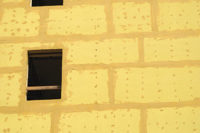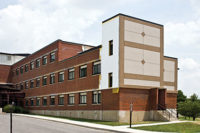Museum Design Solved Through Cladding System
Art Inside and Out

The Art Museum of West Virginia University on the Evansdale Campus in Morgantown, W. Va., was conceived to house the university’s art collection, which includes more than 3,000 objects from Africa and Asia, as well as art from West Virginia, the Appalachian region, and the United States at large.

The Art Museum of West Virginia University on the Evansdale Campus in Morgantown, W. Va., was conceived to house the university’s art collection, which includes more than 3,000 objects from Africa and Asia, as well as art from West Virginia, the Appalachian region, and the United States at large.

The Art Museum of West Virginia University on the Evansdale Campus in Morgantown, W. Va., was conceived to house the university’s art collection, which includes more than 3,000 objects from Africa and Asia, as well as art from West Virginia, the Appalachian region, and the United States at large.

The Art Museum of West Virginia University on the Evansdale Campus in Morgantown, W. Va., was conceived to house the university’s art collection, which includes more than 3,000 objects from Africa and Asia, as well as art from West Virginia, the Appalachian region, and the United States at large.

The Art Museum of West Virginia University on the Evansdale Campus in Morgantown, W. Va., was conceived to house the university’s art collection, which includes more than 3,000 objects from Africa and Asia, as well as art from West Virginia, the Appalachian region, and the United States at large.





The Art Museum of West Virginia University on the Evansdale Campus in Morgantown, W. Va., was conceived to house the university’s art collection, which includes more than 3,000 objects from Africa and Asia, as well as art from West Virginia, the Appalachian region, and the United States at large. The building was to be situated along the main thoroughfare in front of the campus adjacent to a historic building designed by the late American architect Michael Graves, that once housed the alumni center and was renovated in 2009-2010 to serve as the Museum Education Center.
The university’s architectural design guidelines and material standards for the Evansdale Campus included traditional sloped roofs, stucco and stacked stone. Together, the proximity to the Graves building and the new design rules presented a unique set of challenges: How to combine historical motifs and contemporary artistry. The end result is a building comprised of numerous modern details combined with a semi-traditional aesthetic.
Project Notes
Project: The Art Museum of West Virginia University
General Contractor: March Westin Co. Inc.
Architect: Stanley Beaman & Sears
Applicator: Easley & Rivers, Inc.
Distributor: Architectural Interior Products-Fairmont
Products:
- StoGuard - air barrier and moisture protection
- StoDrainScreen - superior drainage and drying
- StoPowerwall stucco - consistent quality impact resistant cladding
One of the techniques used to visually tie the two buildings together was the continuation of the existing datum lines from the adjacent building. These were carried over into the design of the museum—allowing for building elements like joint lines, window heads and sills to align. The designers intermixed the building elements with vertical articulation in a composition inspired by the work of one of the artists featured in the Museum collection, Blanche Lazzell.
Get Started
According to Godfrey Gaisie, AIA, of Stanley Beaman & Sears, the design of the project took approximately one year. Following the design decision process, the designers entered into discussions with the owners on the material to be selected. The university wanted to give the campus a more residential feel and also wanted to match the personality and pitched roof of the alumni center. With the new building connected to the MEC, it was important that it look in sync with that building, while maintaining a progressive vibe. The museum director wanted the outside of the building to reflect the artwork inside, prompting a mixture of modern and traditional, with aspects of elements reminiscent of the legendary Frank Lloyd Wright.
The campus had modern, saw stacked stone on one of its sports facilities, so the designers paired the stacked stone with a StoPowerwall DrainScreen wall system. This is a stucco wall assembly incorporating a continuous air and moisture barrier and advanced cavity wall design. It combines the strength and durability of traditional stucco with moisture protection and Sto’s high-performance finishes. StoPowerwall DrainScreen can be used in residential or commercial wall construction where a combination of air and moisture control and design flexibility is essential.
The manufacturer’s distributor, Architectural Interior Products in Fairmont, W. Va., delivered the system. Sharon Almond, sales rep for AIP and the project liaison declares, “We work with StoGuard often but it was our first time working with DrainScreen. You don’t see a lot of stucco in this region, so it’s very eye-catching, and I would recommend using DrainScreen in any building project.”
Tom Steadman, project manager for Easley and Rivers Inc., was a little uneasy at first, as he hadn’t worked with the system before. “At first it seemed to be an unconventional way of applying a conventional type of plaster system,” says Steadman, “and I was concerned about cracks showing up in the finished product. But we followed Sto’s guidelines to the letter with expansion joint placement and plenty of fasteners to secure the system,” recalls Steadman. “The end result was a system that was aesthetically pleasing and performed just as [the manufacturer] said it would. Their people were very helpful and I realized that my concerns were unwarranted.”
The finished museum is approximately 30 percent stacked stone and 70 percent stucco. According to Gaisie, they used mortar to fill the joints between the stone to prevent water from getting in. Beneath the stucco, StoDrainScreen and StoGuard were used on the 22,000-square-foot building. Originally the university had considered brick; however, the chosen exterior insulation system better matches the existing buildings nearby and is more energy efficient.
“We describe the building as having a modern feel with traditional materials,” said Gaisie. “We used modularity to establish the grid, helping to arrange lines, window heights and door heights. We pulled horizontal lines over from the Graves building, but gave the new building a vertical articulation. Now, the new Art Museum of West Virginia University is the billboard for that side of the campus.”
Looking for a reprint of this article?
From high-res PDFs to custom plaques, order your copy today!











